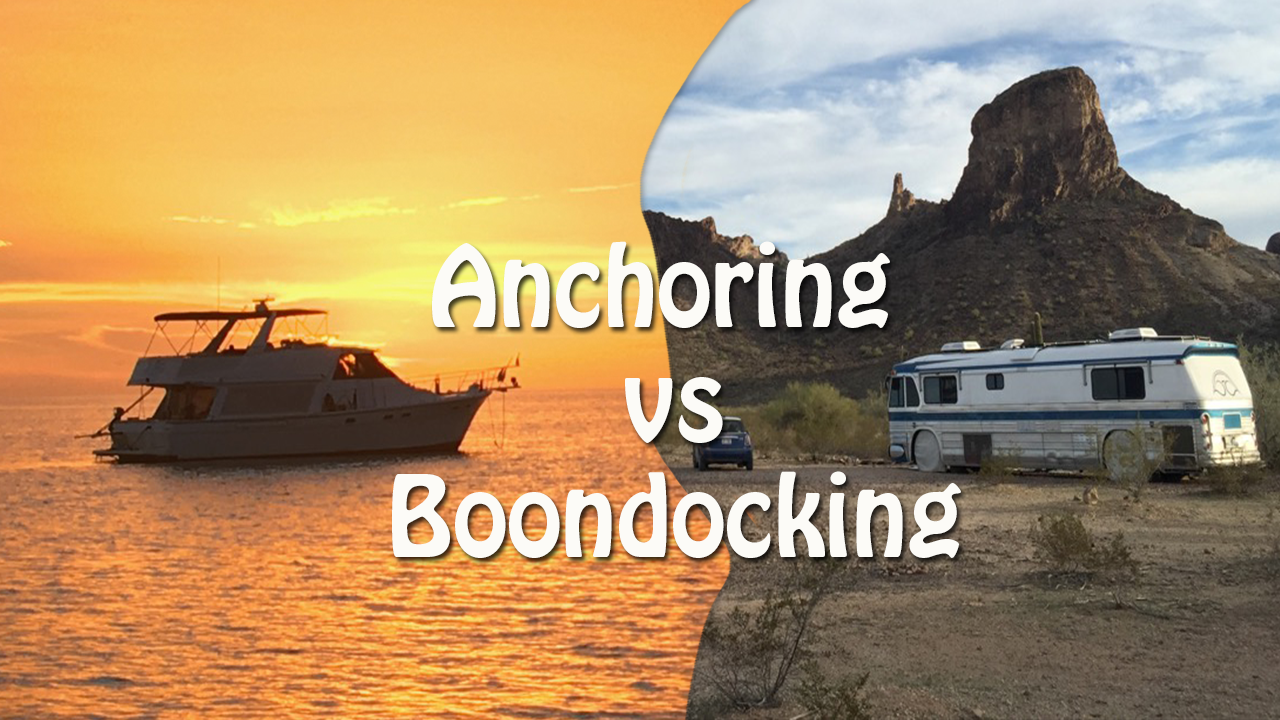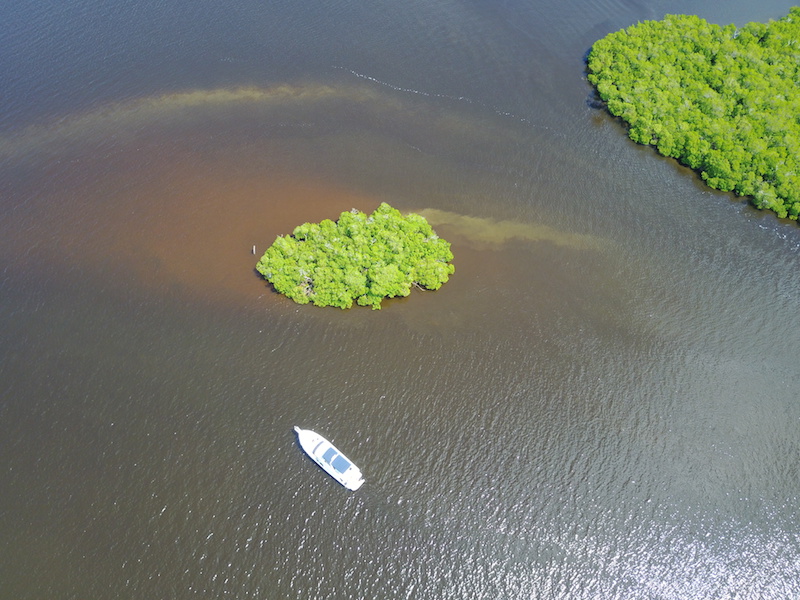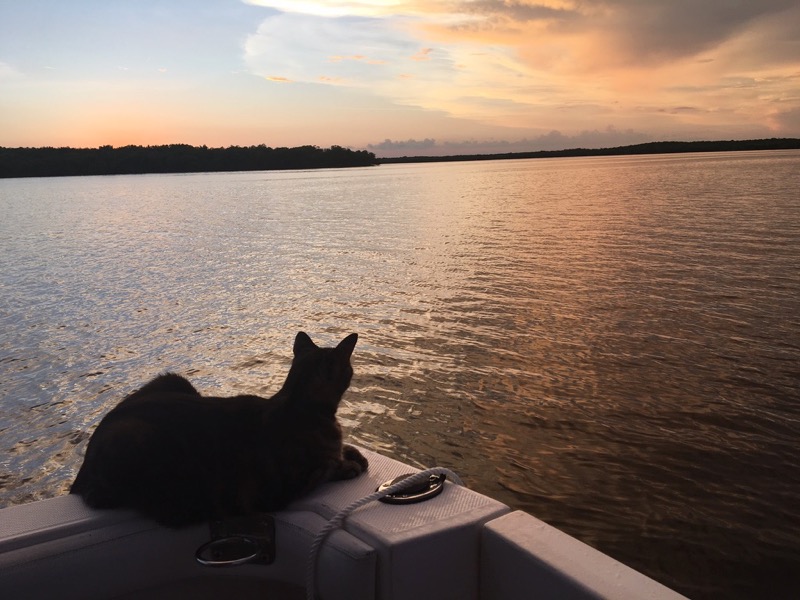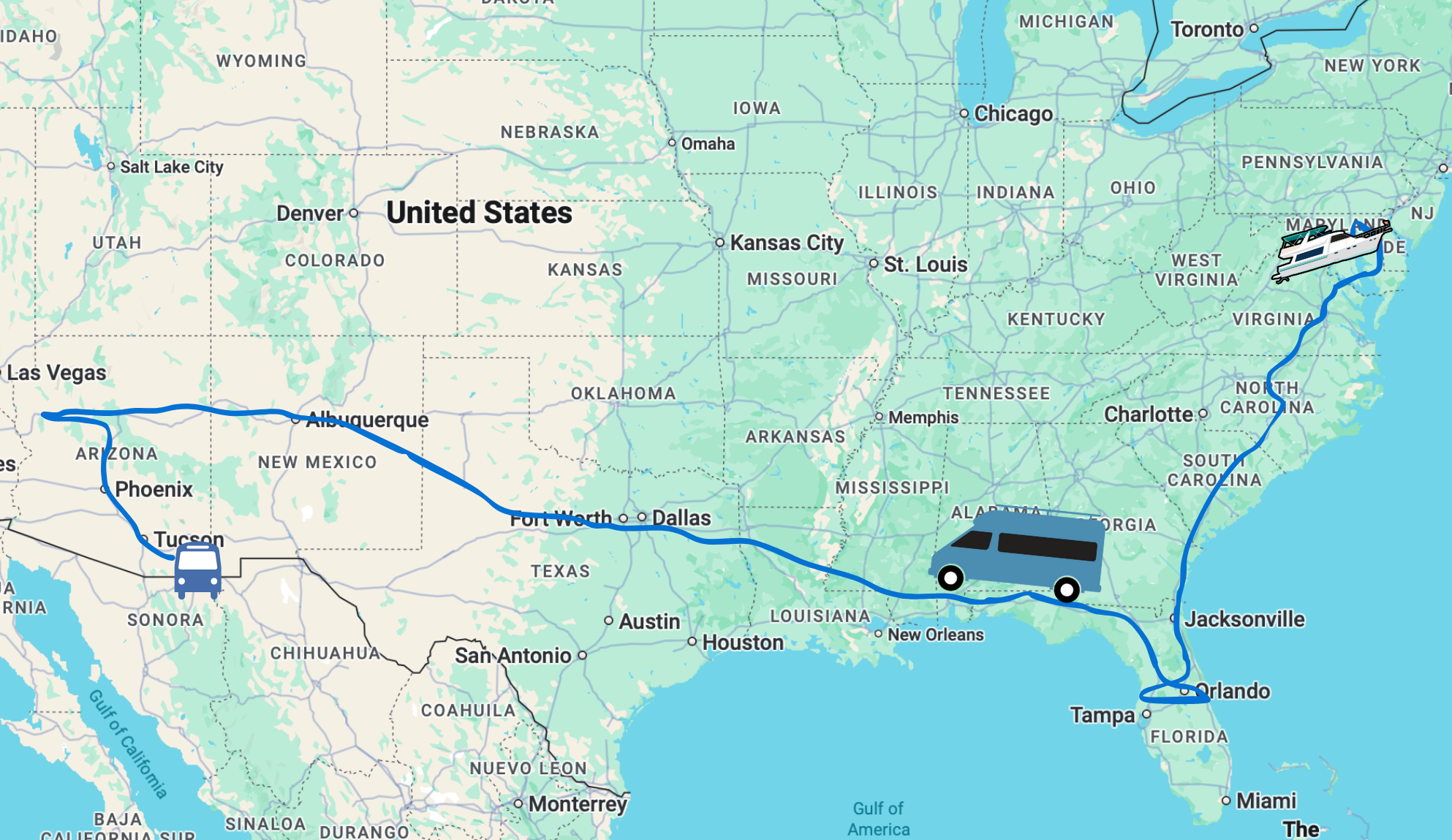
As boating newbies with over a decade of RVing experience, we’re soaking up the new adventure and learning.
In our upcoming travelogues, we’ll be sharing about our latest extended run at anchoring out as we cruised down through the Everglades.
Anchoring out is the boating equivalent of RV boondocking – or being off-grid and self contained. Not in a campground or marina.
For more on boondocking, check out our Guide to RV Boondocking for lots of information on energy, tanks, finding locations and more.
We still consider ourselves just dipping our toes into anchoring. But we’ve taken some notes to share while it’s fresh on our minds.
Recently we hosted a live video cast followed by an engaging Q&A (super fun.. thanks to those who joined in!).
Here’s the 1.5 hr long archive and/or read below for a written summary:
Similarities:
Free

Both anchoring out and boondocking tend to be free – usually on publicly owned lands or waterways.
And, aren’t the best things in life free sometimes?
For us, that’s certainly true.
Some of our most scenic and tranquil stays have been in boondocking and anchoring locations. Often with million dollar views of wide open nature, and relatively on our own.
It’s really our version of a resort.
We’re finding in boating, free anchoring is a very welcomed luxury – because the price differential between a night in a campground ($10-40) and a night in a marina ($60-150) is pretty steep.
Self Contained
With both options, you are away from supplied amenities. No power pedestal. No fresh water tap. No dump station. No marina supplied Wi-Fi (not that it would work anyways).
You have to bring your own and be prepared to be self contained.
But here’s where there are some subtle differences:
-

We love solar power, and are currently working on planning our boat solar install! Power is pretty similar to both RVs and boats – it’s generally supplied by some combination of generator, alternator, battery bank, solar or wind turbine. The biggest difference is wind power is much more common in boating than RVing. The reason being, coastal areas tend to have more consistent wind than where RVers like to boondock.
- Water for both lifestyles is generally obtained at a campground/marina or service station. However, boats setup for open water cruising might have water makers on board – which turns clean salt water into drinkable fresh water. We don’t have one on board (for why: our quick video FAQ).
- Waste management is where things are different. RVs tend to have a black (toilet) and grey (shower/sink) tank to hold waste water and utilize easy to find dump stations. Boats usually discharge grey water overboard and have black tanks emptied at pump out stations (which are much more difficult to find). However, for those going offshore it is legal beyond a certain distance (3-9 miles) to dump black water overboard.
- Internet, well, that’s actually pretty similar for us – one reason we picked the Great Loop. We’re staying connected off the same cellular data plans we use in RVing. We have a grandfathered Verizon plan and a AT&T Unlimited Plus hotspot – total cost, $65/month. (Our guide: Unlimited Data Plans.). Biggest difference is directional antennas for signal enhancing and boats don’t work as well (see below about anchoring not being still).
Researching Your Options

Just like with boondocking sources like Campendium, Freecampsites, and Allstays, we keep abundant in options.
For boating we use the equivalent Active Captain, Waterway Guide and Skipper Bob.
And of course there are secret gems shared only by word of mouth and via social media.
And just like with RV boondocking, the research doesn’t stop at just finding the location – you still need to scout it out cautiously once you arrive.
Except with anchoring out, you don’t have the benefit of visually seeing the ground you’ll be anchoring to (usually) and it’s not as easy to just “pull off the road” and check it out. So you rely on good charts, anchorage reviews, your depth sounder, and your wits as you carefully approach.
We’ve also found our new drone (a DJI Mavic Pro – which we LOVE) to be useful for visually inspecting from the air for an ideal spot.
Differences
Options
Especially along the east coast, we’re finding anchorages much more numerous than RV boondocking options. There’s just not as much public land on the eastern half of the US, so boondocking opportunities are fewer and far between than out west. But anchorages in coastal areas are pretty easy to come by.
Of course, there’s not too many coastal accessible anchorages in Arizona, Utah or Colorado.
Ok. Probably none.
One reason why we very much look forward to returning to RVing in the winters. Because we love boondocking out west.
The Yard Around You

Ok, so here’s one we knew in theory – but it wasn’t until we were boat-bound for days that it really hit home.
When you’re boondocking, you pull into a spot, open your door – and viola – the world is yours to explore.
You put on your shoes (or maybe not), step outside and go for a nice long amazing hike. You pull out some chairs and enjoy your front porch. You can repeat as often as you like with no obstacles except perhaps tripping over the cat.
Ok. Anchoring.. definitely not the same.
There’s a reason the word ‘anchored’ is often followed with the word ‘out’.
Because you are OUT.

You drop your anchor and guess what? You’re surrounded by water.
You step out your door and you’re swimming (or being eaten by alligators or sharks, or taken away by the current).

Want to go for a walk? Your options are pacing circles around your boat (still tripping over the cat, of course) or taking your dinghy to shore.
Assuming there is a shore. There might not be.
We talk about this more in our next series of videos, but on our Everglades repositioning we visited six different anchorages. They were all gorgeous. Beautiful.
And made for fantastic Instagram shots and drone footage.
Ahhh.. rainbows.

But three had no shore access within miles.
And the other three were relatively short beaches swarming with mosquitos, biting flies and noseeums.
Freaking rainbow farting unicorns!
We did honestly go a little stir crazy and sped up our repositioning by several days.
Thank goodness we opted for a larger boat, because it is our little island of everything while anchored.
We know passage making sailors (like our buddies the Wynn’s who just crossed to Panama) spend far more time without land in site.
But it is definitely something us landlubbers need to get used to. Hopefully not all anchorages in our future will be as water-locked as the Everglades.
Anchored Doesn’t Mean Still
So, back to that boondocking spot you’ve pulled into.
After you set the brakes and deploy the levelers and chocks – you can pretty much assume your RV will stay exactly where you put it. Aside from a freak weather incident resulting in a landslide or major flooding, you can consider yourself parked.
And still.
Anchoring? Not so much.

Water is fluid (duh). Your boat will move with it.
You’ll gently bob around in the best of conditions. Get some unsettled seas (“unsettled seas” sound so innocuous, huh?) … you’ll pitch and roll like there’s no tomorrow.
A boat passes nearby a bit too quickly? You get to rock in their wake.

You just get used to always being on guard to brace yourself and everything around you.
Your boat will also be constantly swinging around the anchor point as the winds and tidal currents change (your bow will go into the prevailing wind or current). Most of the time this is an enchanting experience with your view constantly changing.
But each time you swing around, your anchor unsets and usually quickly resets.
But it might not – and your anchor drags. Hopefully resetting before your boat smashes into something or you bottom out in shallower water. We set anchor alarms via GPS to alert us.. and alert we stay.
We’re told by more experienced cruisers, you just get used to it. You take notice and then go back to walking in circles in your salon tripping over the cat.
But for us newbies, we’re still extra on guard.
While anchoring out is mostly absolute isolated gorgeous bliss, we have experienced more moments of near terror than in all our years of boondocking.
And of course, those moments always seem to happen in the pitch blackness of night.
But we love it…
We love new challenges and learning experiences, and so far – cruising is living right up to our expectations. We fully anticipate the learning will continue! Bring it!


As a long time, now retired, commercial fisherman from the NW, Gulf of Alaska and Bering Sea, I love that you are exploring the sailing aspect of traveling. My wife gets terribly seasick so that will not be an option for us. We currently have a new 5th wheel and truck and will be on the road again come November. I had never heard about the Great Circle Route until you mentioned it. Sounds awsome. I don’t know it you plan to travel to the west coast. I’ve transversed the Panama Canal twice and made several trips up the inside passage to Alaska and the Bering Sea. Wild and beautiful. I could spend my life there, except to the aforementioned seasick person.
Loving this comparison! So true, you are definitely making me want to go on a boat trip!
One way to avoid the anchor resetting issue is to use a second anchor in a “Bahamian Moor” http://www.sailingtoday.co.uk/practical/set-bahamian-moor/
Also, When you guys get to Maine on the loop (I’m assuming this will be next year sometime) PLEASE look me up. Casco Bay is my home turf where I fished for lobster for several years and my dad has a wharf overlooking some awesome anchorage spots where I am sure he would be happy to let you tie up your dinghy for some time ashore. There is a Marina nearby also for fuel and other services (and a GREAT restaurant – try the chowdah!). And I would be happy to be your guide around the Islands of Casco Bay!!
Definitely an anchor-skill on our to-do list to learn!
Maine actually isn’t on the Great Loop, you cut into the Hudson in NY Harbor and head to the Great Lakes from there (but some take a side trip that way). Not sure if we will or not, that’s still a long ways off for us 🙂
We loved our RVing time up in Maine last year, and are itching to return.
Have you ever thought of 2 Anchors? One at the front and one at the rear of the boat wil hold you in one place forever.
Yes, we definitely need to learn this anchoring skill.. it’s on our list!
Until now, I wasn’t aware of ICW. It’s amazing to me that it goes all the way up the east coast. I had just assumed that you had no alternative but to skirting the coast in the ocean. Do you plan to use the ICW much of the way?
Pretty cool, isn’t it? And yes, we’ll be following the ICW – that’s the traditional route for the Loop and keeps us in more protected waters. Maybe on some good weather days we may dip out into the ocean to mix it up.